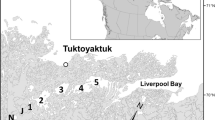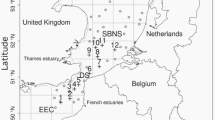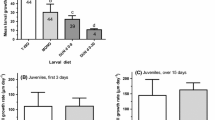Abstract
Individual growth rates, and thus sizes at a given age, vary within cohorts of fishes reared in the laboratory, field enclosures, and the wild, but the causes of this variability are poorly understood. We examined effects of three variables (food availability, a diet shift, and fish density) on growth depensation in red drum, Sciaenops ocellatus, larvae in laboratory experiments. Absolute variance in length of larvae was greater with higher food availability, and relative variance (CV) for a cohort at 14 d posthatching was positively correlated with its CV at 7 d posthatching, over which time CV doubled. Supplementation of a rotifer diet with Artemia nauplii (diet shift) increased growth rate and length variance, but not CV. Individually-reared and group-reared larvae had similar growth rates, but group-reared larvae exhibited higher CVs than individually-reared larvae. The observation that food availability and diet shifts affected absolute size variance, while fish density affected relative size variance of red drum larvae, indicates that both absolute and relative size variance are important to understand how environmental factors affect growth depensation.
Similar content being viewed by others
References cited
Allen, G.R. 1972. The Anemonefishes: Their Classification and Biology. T.F.H. Publications, Neptune City. 288 pp.
Arnold, C.R. 1988. Controlled year-round spawning of red drum Sciaenops ocellatus in captivity. Contrib. Mar. Sci. 30(Suppl.): 65-70.
Beyer, J.E. & G.C. Laurence. 1980. A stochastic model of larval fish growth. Ecol. Modell. 8: 109-132.
Blaxter, J.H.S. 1976. Reared and wild fish-howdo they compare? pp. 11-26. In: G. Persoone & E. Jaspers (ed.) Tenth European Symposium on Marine Biology. Vol. 1, Institute for Marine Scientific Research, Bredene, Belgium.
Blaxter, J.H.S. 1988. Pattern and variety in development. pp. 1-58. In: W.S. Hoar & D.J. Randall (ed.) Fish Physiology. Vol. 11, Academic Press, San Diego.
Brown, M.E. 1946. The growth of brown trout (Salmo trutta Linn.). I. Factors influencing the growth of trout fry. J. Exp. Biol. 22: 118-129.
Buckley, L.J., S.I. Turner, T.A. Halavik, A.S. Smigielski, S.M. Drew & G.C. Laurence. 1984. Effects of temperature and food availability on growth, survival, and RNA-DNA ratio of larval sand lance (Ammodytes americanus). Mar. Ecol. Prog. Ser. 15: 91-97.
Chambers, R.C., W.C. Leggett & J.A. Brown. 1988. Variation in and among early life history traits of laboratory-reared winter flounder Pseudopleuronectes americanus. Mar. Ecol. Prog. Ser. 47: 1-15.
Chick, J.H. & Van Den Avyle, M.J. 1999. Effects of zooplankton spatial variation on growth of larval striped bass: An experimental approach. Trans. Amer. Fish. Soc. 128: 339-351.
Cowan, J.H. Jr., E.D. Houde & K.A. Rose. 1996. Size-dependent vulnerability of marine fish larvae to predation: An individualbased numerical experiment. ICES J. Mar. Sci. 53: 23-37.
Davis, M.W. & B.L. Olla. 1987. Aggression and variation in chum salmon (Onchorynchus keta) juveniles in seawater: Effects of limited rations. Can. J. Fish. Aquat. Sci. 44: 192-197.
Eklöv, P. 1992. Group foraging versus solitary foraging efficiency in piscivorous predators: The perch, Perca fluviatilis, and the pike, Esox lucius, patterns. Anim. Behav. 44: 313-326.
Fitzhugh, G.R., L.B. Crowder & J.P. Monaghan, Jr. 1996. Mechanism contributing to variable growth in juvenile southern flounder (Paralichthys lethostigma). Can. J. Fish. Aquat. Sci. 53: 1964-1973.
Folkvord, A., V. Øiestad & P.G. Kvenseth. 1994. Growth patterns of three cohorts of Atlantic cod larvae (Gadus morhua L.) studies in a macrocosm. ICES J. Mar. Sci. 51: 325-336.
Fuiman, L.A. 1994. The interplay of ontogeny and scaling in the interactions of fish larvae and their predators. J. Fish Biol. 45(Suppl. 1A): 55-79.
Fuiman, L.A. 2002. Special considerations of fish eggs and larvae. pp. 1-32. In: L.A. Fuiman & R.G. Werner (ed.) Fishery Science: The Unique Contributions of Early Life Stages. Blackwell Science, Oxford.
Fuiman, L.A., K.R. Poling & D.M. Higgs. 1998. Quantifying developmental progress for comparative studies of larval fishes. Copeia 1998: 602-611.
Fukuhara, O. 1983. Development and growth of laboratory reared Engraulis japonica (Houttuyn) larvae. J. Fish Biol. 23: 641-652.
Goldan, O., D. Popper, S. Kolkovski & I. Karplus. 1998. Management of size variation in juvenile gilthead sea bream (Sparus aurata) II. Dry food type and live/dry food ratio. Aquaculture 165: 313-320.
Hecht, T., S. Battaglene & B. Talbot. 1996. Effect of larval density and food availability on the behaviour of pre-metamorphosis snapper, Pagrus auratus (Sparidae). Mar. Freshwat. Res. 47: 223-231.
Holt, G.J. & S.A. Holt. 2000. Vertical distribution and role of physical processes in the feeding dynamics of two larval sciaenids Sciaenops ocellatus and Cynoscion nebulosus. Mar. Ecol. Prog. Ser. 193: 181-190.
Houde, E.D. 2002. Mortality. pp. 64-87. In: L.A. Fuiman & R.G. Werner (ed.) Fishery Science: The Unique Contributions of Early Life Stages. Blackwell Science, Oxford.
Huang, W.B. & T.S. Chiu. 1997. Effects of stocking density on survival, growth, size variation, and production of Tilapia fry. Aquacult. Res. 28: 165-173.
Hunter, J.R. & C.A. Kimbrell. 1980. Early life history of Pacific mackerel, Scomber japonicus. Fish. Bull. U.S. 78: 89-101.
Jones, C.M. 2002. Age and growth. pp. 33-63. In: L.A. Fuiman & R.G. Werner (ed.) Fishery Science: The Unique Contributions of Early Life Stages. Blackwell Science, Oxford.
Jørgensen, E.H., J.S. Christiansen & M. Jobling. 1993. Effects of stocking density on food-intake, growth-performance and oxygen-consumption in Arctic charr (Salvelinus alpinus). Aquacult. 110: 191-204.
Keast, A. & J.M. Eadie. 1985. Growth depensation in year-0 largemouth bass: The influence of diet. Trans. Am. Fish. Soc. 114: 204-213.
Kinghorn, B.P. 1983. A review of quantitative genetics in fish breeding. Aquacult. 31: 283-304.
Koebele, B.P. 1985. Growth and the size hierarchy effect and experimental assessment of three proposed mechanisms; activity differences, disproportional food acquisition, physiological stress. Environ. Biol. Fishes 12: 181-188.
Li, H.W. & R.W. Brocksen. 1977. Approaches to the analysis of energetic costs of intraspecific competition for space by rainbow trout (Salmo gairdneri). J. Fish Biol. 11: 329-341.
Magnuson, J.J. 1962. An analysis of aggressive behavior, growth, and competition for food and space in medaka (Oryzias latipes (Pisces, Cyprinodontidae)). Can. J. Zool. 40: 313-363.
Miller, T.J., L.B. Crowder, J.A. Rice & E.A. Marschall. 1988. Larval size and recruitment mechanisms in fishes: Toward a conceptual framework. Can. J. Fish. Aquat. Sci. 45: 1657-1670.
Nakamura, N. & S. Kashara. 1956. A study on the phenomenon of the Tobi-Koi or shoot carp-II. On the effect of particle size and quantity of food. Bull. Japan. Soc. Fish. Oeanogr. 21: 1022-1025.
Paller, M.H. & W.M. Lewis. 1987. Effects of diet on growth depensation and cannibalism among intensively cultured larval striped bass. Prog. Fish-Cult. 49: 270-275.
Papoutsoglou, S.E., G. Tziha, X. Vrettos & A. Athanasiou. 1998. Effects of stocking density on behavior and growth rate of European sea bass (Dicentrarchus labrax) juveniles reared in a closed circulation system. Aquacult. Eng. 18: 135-144.
Rice, J.A., T.J. Miller, K.A. Rose, L.B. Crowder, E.A. Marschall, A.S. Trebitz & D.L. DeAngelis. 1993. Growth rate variation and larval survival: Inferences from an individual-based size-dependent predation model. Can. J. Fish. Aquat. Sci. 50: 133-142.
Rooker, J.R. & S.A. Holt. 1997. Utilization of subtropical seagrass meadows by newly settled red drum Sciaenops ocellatus: Patterns of distribution and growth. Mar. Ecol. Prog. Ser. 158: 139-149.
Rooker, J.R., S.A. Holt, M.A. Soto & G.J. Holt. 1998. Postsettlement patterns of habitat use by sciaenid fishes in subtropical seagrass meadows. Estuaries 21: 318-327.
Ryer, C.H. & B.L. Olla. 1996. Growth depensation and aggression in laboratory reared coho salmon: The effect of food distribution and ration size. J. Fish Biol. 48: 686-694.
Secor, D.H. & J.M. Dean. 1992. Comparison of otolith-based back-calculation methods to determine individual growth histories of larval striped bass Morone saxatilis. Can. J. Fish. Aquat. Sci. 49: 1439-1454.
Sogard, S.M. 1997. Size-selective mortality in the juvenile stage of teleost fishes: A review. Bull. Mar. Sci. 60: 1129-1157.
Sogard, S.M. & B.L. Olla. 2000. Effects of group membership and size distribution within a group on growth rates of juvenile sablefish Anoplopoma fimbria. Envir. Biol. Fishes 59: 199-209.
Stefánsson, M. Ö., A.K. Imsland, M.D. Jenssen, T.M. Jonassen, S.O. Stefansson & R. Fitzgerald. 2000. The effect of different initial size distributions on the growth of Atlantic halibut. J. Fish Biol. 56: 826-836.
Umino T., K. Arai & H. Nakagawa. 1997. Growth performance in clonal carp, Carassius langsdorfii. Effects of genetic difference and feeding history. Aquacult. 155: 271-283.
Zweifel, J.R. & R. Lasker. 1976. Prehatch and posthatch growth of fishes-a general model. Fish. Bull. 74: 609-621.
Author information
Authors and Affiliations
Rights and permissions
About this article
Cite this article
Smith, M.E., Fuiman, L.A. Causes of Growth Depensation in Red Drum, Sciaenops Ocellatus, Larvae. Environmental Biology of Fishes 66, 49–60 (2003). https://doi.org/10.1023/A:1023240524984
Issue Date:
DOI: https://doi.org/10.1023/A:1023240524984




